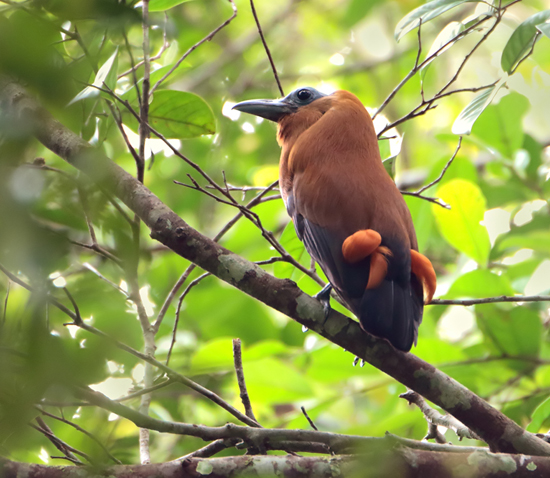(update link) |
KCFoggin-243 (talk | contribs) |
||
| Line 1: | Line 1: | ||
'''Alternative name: Calfbird''' | '''Alternative name: Calfbird''' | ||
| − | [[Image: | + | [[Image:CapuchinbirdAdA.jpg|thumb|550px|right|Photo by {{user|Anselmo+d+Affonseca|Anselmo d Affonseca}}<br />[[Manaus]], [[Brazil]], September 2016]] |
;[[: Category:Perissocephalus|Perissocephalus]] tricolor | ;[[: Category:Perissocephalus|Perissocephalus]] tricolor | ||
==Identification== | ==Identification== | ||
Revision as of 17:59, 24 September 2016
Alternative name: Calfbird
- Perissocephalus tricolor
Identification
About 35 cm = 13-14 inches. Unmistakable: Black tail, olive-brown wings, mostly rufous in rest of plumage, blue-gray in bare parts of head with dark, large bill. Sexes alike.
Distribution
Venezuela, extreme eastern Colombia, the Guianas, and northern Brazil1.
Taxonomy
This is a monotypic species[4].
Habitat
Humid forest on non-swampy ground. Usually below 600m but p to 1400m in Venezuela.
Behaviour
Diet
Feeds mainly on fruits but takes also large insects.
Breeding
Breeding season November to March in Suriname, July to October in French Guiana. The nest is a light platform with twigs, usually 3 to 6 m high in a understorey tree. Lays one egg.
Resident species.
Courtship
Maybe the strangest display in this family. Males display at a lek, standing upright with their bald heads gleaming and uttering their strange, cow-like sound. A dominant male sits on a key perch, together with his allies. Other males also associate, trying to get better places in the lek. The lek is visited by groups of females. Their visit leads often to chaos with agression between the females, males mimicring females to get better places in the leks and agression between males. Usually, the dominant male seems to do all the matings.2 The fact that both sexes exhibit aggression at the lek may explain why both sexes are plumaged alike, contrary to most other lekking species.
Vocalisation
A cow-like mooing by the males. Females utter a rasping "waaaaaaa" as an alarm.
References
- Restall et al. 2006. Birds of Northern South America. Yale University Press. ISBN 9780300124156
- Del Hoyo, J, A Elliot, and D Christie, eds. 2004. Handbook of the Birds of the World. Volume 9: Cotingas to Pipits and Wagtails. Barcelona: Lynx Edicions. ISBN 978-8487334696
- Morton & Stutchbury (2001): Behavioral Ecology of Tropical Birds. Academic Press. ISBN 0-12-675556-6
- Clements, JF. 2009. The Clements Checklist of Birds of the World. 6th ed., with updates to December 2009. Ithaca: Cornell Univ. Press. ISBN 978-0801445019.
Recommended Citation
- BirdForum Opus contributors. (2024) Capuchinbird. In: BirdForum, the forum for wild birds and birding. Retrieved 16 May 2024 from https://www.birdforum.net/opus/Capuchinbird




